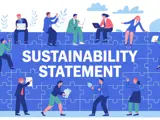Q&A with Kōan: An inside look on preparing Sustainability Statements
Under the evolving and complex European Sustainability Reporting Standards (ESRS), companies face various challenges when preparing Sustainability Statements. In this Q&A, Neil Smith, our Strategic Director, shares his experience. He discusses common pitfalls, the complexities of data preparation and design, and the growing need for collaboration.
What kind of challenges do companies face when transitioning from traditional sustainability reports to Sustainability Statements?
Neil: It’s two things. One is just understanding the requirement — it’s a pretty complex and technical regulation. It is being simplified, which is good, but even then, it’s a lot. And the second is getting the business ready. By that, I mean getting the right people involved and having the right data to meet the requirements.
Most companies know the regulation exists. But knowing it and actually being ready to comply are two very different things. That’s where we see companies struggling. Whether it’s listed clients or those doing voluntary statements — they’re all feeling overwhelmed by the volume of data needed. Hopefully, the omnibus simplification helps with that.
Do you think companies underestimate the timeline or complexity involved in preparing Sustainability Statements?
Neil: 100%. Many companies think they're ready because they’ve read the regulations. But when it’s time to do the work, they realise they’re not. We’ve seen that happen with clients — big or small. That’s why producing Sustainability Statements voluntarily — for example, a year ahead of regulatory obligation — is useful: they give companies a chance to practice before they’re required to comply.
Some companies try to hand it off to one person or one department — but that doesn’t work because it’s too much work. You need a cross-functional team to be successful. Finance often takes the lead, which makes sense because they’re used to regulatory reporting. But they’re not always familiar with non-financial data. So, you need people from across the business — sustainability, operations, HR — working together. It’s similar to integrated reporting, but more demanding and more heavily scrutinised.
Focusing on the design, formatting and layout aspects of Sustainability Statements, could you elaborate on the issues companies generally encounter?
Neil: Teams are often too stretched to prioritise design. They are so focused on data and compliance that design becomes an afterthought. They’ll use the same design agencies they’ve used for years, but those agencies may not understand the structure of these regulatory disclosures.
The ESRS has specific format requirements such as for tables (at least for now as the revised ESRS is expected to introduce more structural flexibility, which will improve readability) and it is common practice for companies to tag disclosure requirements in their Sustainability Statements. If these aren’t followed, it can confuse auditors. But as we all get more comfortable with the regulation, I think we’ll definitely see more creativity in how the reports are designed.
Do you think creative approaches to Sustainability Statements can help address some of the issues you mentioned around design and formatting?
Neil: They can — but probably not right away. Right now, everyone’s just trying to get the basics right: the data, the disclosures, the structure. We’ve experimented with a few clients, but often it’s too much too soon. That said, there’s real potential for design to support content once teams have the space and time to think creatively – and of course that’s also where we can help.
Could you also share your thoughts on the role of data visualisation, and the more interactive elements in enhancing Sustainability Statements?
Neil: That’s one of my favourite topics. There’s a lot of opportunity here, especially because the structure of Sustainability Statements lends itself to good data visualisation. Unlike principles-based frameworks, this is prescriptive. That makes it easier to compare and analyse data across companies and sectors. But to do it well, you need the right people — people who understand the data, designers, developers, storytellers. It's a team effort.
Also, companies should think about the end user. Who's going to read this? NGOs? Investors? Potential employees? What would they find useful or engaging? Even if you’re not building fancy visualisations, just keeping the user in mind can help you present your data more clearly and make your report more effective.
Get comfortable, there’s more
If you enjoyed this article, there's plenty more media to get your mind into.
Sign up to our newsletter
and we'll report back to you with industry news and updates you'll actually want to know.




